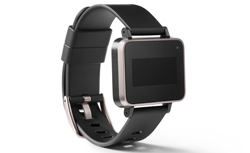 |
| Google's health-tracking wristband device--Courtesy of Google |
Google ($GOOG) has revealed its pitch to establish wearables as a cornerstone of clinical trials. The wristband health tracker is aimed squarely at the clinical trial and healthcare sectors, setting it apart from consumer-focused rivals from Apple ($AAPL) and Fitbit ($FIT).
Bloomberg reports the device will track the wearer's pulse, heart rhythm and skin temperature, a mix that is comparable to the upper end of what is achievable on existing health trackers. Google's ability to differentiate its device from these alternatives will depend on its capacity to reassure clinical trial sponsors and physicians about the reliability of the data gathered by the device, as well as demonstrate the value of additional features such as the ability to track light exposure, noise level and other environmental metrics.
The team behind the project has the pedigree to create a device that stands out from the crowd. Work on the device is taking place at the search giant's experimental Google X research unit, the same group that developed the Novartis ($NVS)-partnered smart contact lenses and much-hyped driverless cars. And the team knows what it will take for a device to crack the clinical trial sector. Andy Conrad, head of the life sciences team at Google, said the focus has been on creating a device that is rigorous, accurate and reliable enough to generate regulatory-submission-quality data.
Early tests of whether Google has achieved its goal are scheduled to start this summer. The plan is to work with academic researchers and biopharma companies to assess the accuracy of the device. If the data meet Google's expectations, the company plans to file for regulatory approval in the U.S. and Europe. Beyond that, the publicly disclosed plan is hazy, although Google has previously said it wants to partner its life science innovations to free itself from the regulatory burdens inherent to the industry. For the wearable, that process could start with the enlisting of a production partner.
- read Bloomberg's article